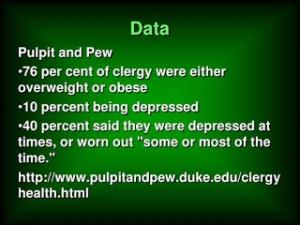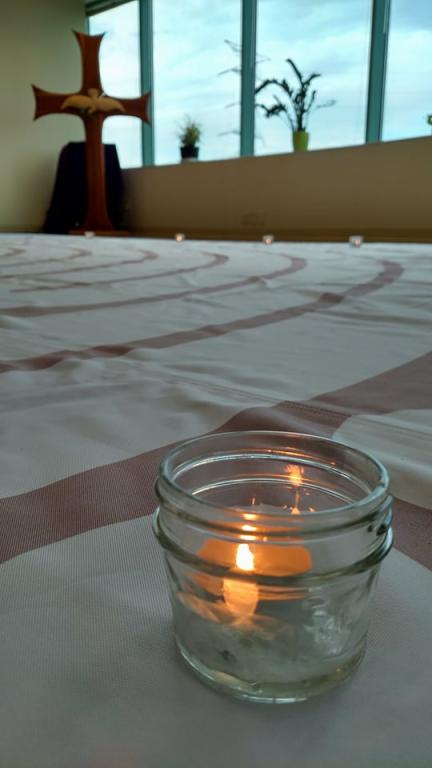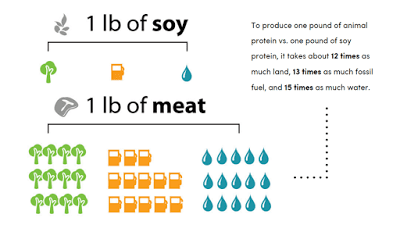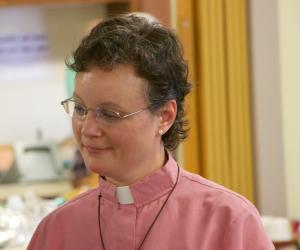Healthy pastor = healthy congregation + healthy planet
As the New Year begins, this is the season to encourage each other to take steps toward better health, healing and wholeness in mind, body, emotions and relationships. This is especially true for pastors and their congregations.

I’m ordained in the Lutheran church (ELCA) and learned from our benefit service provider that clergy health in our denomination is a serious concern. Clergy have high rates of stress, weight problems, hypertension, depression and heart problems. Poor health among clergy has become so widespread, it is becoming a characteristic of the profession.
Clergy health care costs as a group are 23% higher than other comparable groups.
This is reflected in the skyrocketing costs of health care for clergy and congregations. Clergy work is stressful, and our population has a higher incident rate of chronic conditions like diabetes, heart disease, asthma, kidney disease, and heart failure than other professions. (Check out this article in the Christian Century that further explains the problem of clergy health.)

Not only do our unhealthy lifestyles hurt us as pastors, they also contribute to our planet’s “health crisis.”
Our society is structured around manufactured need/greed for excessive and unchecked “growth.” This leads to unrelenting demands that we place upon ourselves, each other, and the planet to supply us with more and more, without consideration of the consequences. This leads to depletion. We experience this depletion on a personal level, in our relationships, and at the ecological level. We can see this mirrored in our planet which is experiencing a feedback loop of exponentially increasing pollution, climate change, and ecosystem collapse.
In the human body, there is a name for cells that grow without rest, consume all surrounding resources, and take over the system. It’s called cancer.
The kind of growth envisioned by our consumerist culture has in many ways affected the church. This leads to ill health at best, and death at worst. So what can we do to help create a healthy pastor, which can also contribute to a healthier planet?
In 2015 the ELCA asked clergy to make lifestyle choices and changes that have tangible positive outcomes.
In response, I took a serious look at my habits to see how I could better steward the body, mind, and spirit I used to serve my congregation.
I wanted to see what I could tweak or reshape to better reflect the blessings God wants me to enjoy.
As part of my discernment, I realized that the Commandment that I broke most often is the one about honoring the Sabbath. Yes, I led worship nearly every Sunday. But many months I did not take a weekly day of rest. I also did not exercise as much as necessary. And there is my family history of heart disease, stroke and high blood pressure, as well as my own level of stress. So I realized that I could be a risk for the congregation and the church as a whole if I did not take steps to better care for myself. This was not living the life of a healthy pastor. So I committed to 5 steps to improve my own health and well-being, which, in turn, would better serve the church and the planet. (Of course, these are not the only steps that can lead to better spiritual, mental, emotional and physical health. This is just a suggested place to start.)

Photo credit: Leah D. Schade. All rights reserved.
Step One: Sabbath
Not for nothing is this one of the first three commandments! As a pastor, I strove to honor the day of rest once a week. Usually this was on Fridays. On these days I engaged in the activities that strengthened my relationships with God, family and friends, and God’s Creation.
You can do this, too, to help yourself become a healthy pastor. Take walks in nature alone or with friends. Meditate or practice yoga. Journal. Read scripture. Play games (board games and physical games) with kids. Take “artist dates” with yourself to rejuvenate your creativity (an idea from The Artist’s Way by Julia Cameron). Have “play-dates” with your spouse or a close friend. Choose whatever disengages you from the daily and weekly sprint of ministry so that you can rest and be ready for the next cycle of work. [Read this great article on why we need regular rhythms of alternating work and rest: https://hackernoon.com/why-working-in-sprints-maximizes-human-productivity-e01c605ec296.]
Step Two: Exercise
I committed to adding one additional day of high-energy exercise each week and committed to walking at least 20 minutes each day, or 40 minutes every other day. But for pastors, finding time to exercise can be a challenge.
So I found a way to do ministry and exercise at the same time.
I had “walking” pastoral meetings with people – youth and adults alike. We would meet at a park or simply walk the perimeter of the church property. Or I would make my pastoral phone calls while I walked. (I made sure to do this in a place with little to no people, so as to protect private conversations.) That way, I could piggy-back two important tasks – pastoral care and self-care. This also encouraged my parishioners to engage in the exercise of walking as well. Healthy pastor, healthy parishioners!
Step Three: Nutrition
In October of 2015, I eliminated meat from my diet. I committed to being a pescatarian – not eating meat, but allowing fish and seafood. This is not only good for my health, but also for our planet’s well-being (see also http://www.cowspiracy.com/facts/). I realize going vegan is the ideal, and my goal is to get to that at some point.

But if going “cold turkey” on meat-eating (pun-intended) feels like to big of a step for you, start small. Try cutting out meat just one day a week (Meatless Mondays, for example). By eating lower on the food chain, you’ll be doing the planet – and your body – a favor. Healthy pastor, healthy planet!
Step Four: Accountability
This is the really vital step. Because no resolutions will be effective if you don’t have to answer to someone. So I committed to being accountable to our church Council and the congregation about the steps I was taking to improve my health. In my monthly pastor’s report, I included information about how many hours I had exercised, and what days I took my sabbath. I wrote about my health-and-wellness commitment in my column for our newsletter. And I preached a Lenten sermon series entitled “Metanoia – Turning Toward Health and Faith.” I also asked for the congregation’s prayerful support and encouragement.
You can do this with your congregation, too. Talk with your mutual ministry committee about your goals, and ask them to keep you accountable as a healthy pastor. Partner with a fellow clergyperson to pursue health-and-wellness goals this year, and then check in with each other on a regular basis. (You might even consider reaching out to clergy of a different denomination or religion than your own.) For the healthy pastor, it’s easier to step into this journey when you have accountability partners.
Step Five: Prayer
I prayed that God would give me the will and the willpower to take care of the temple of my mind, body and emotions that have been entrusted to me. And I asked for God to lead me in stewarding the relationships that are a reflection of the Divine Love that seeks to enfold me in grace. You, too, can incorporate your health-and-wellness goals into your prayer life.

Try a centering prayer just as you’re waking up, asking God to give you the vision to see yourself living into the life of health God intends for you. Pause prayerfully before each meal to reflect on the sourcing of your food, how it was processed, and who was involved in bringing this nutrition to you. As you are engaging in your exercise routine, pray while you stretch. Give thanks for your body, your breath, and all those who have contributed to your being. Ask a blessing on each part of your body. Your hands that will hold those of a parishioner in prayer. The feet that will walk you to your lunch meeting. Your lungs that will breathe life into your leading of worship. Even your butt that will be supporting you in the chair while you’re at the computer working on your sermon!
And in the evening before you fall asleep, release the day as an offering to God. As Martin Luther said, prayer should be “the key to the day, and the lock to the night.”
My hope in becoming a healthy pastor was that I would model for my congregation what it looks like to take positive steps toward better health.
These days I’m a seminary professor teaching preaching and worship. While the demands of academia are different than ministry, the intensity of the work remains. And I realize that it’s important to model for my students what it means to lead a life shaped by intentions toward health and wholeness. So I am recommitting to these 5 steps.
But I also know how difficult it is to make good on these intentions as a pastor.
Illnesses and deaths in our congregations happen. Meetings and events are scheduled. Reports are due. The youth retreat is coming up. The surprise vermin in the sacristy demands attention. And Sunday comes EVERY WEEK!
So what has worked for you? And what are your challenges?
What are your successes and growing edges when trying to live a healthy life as a clergy person? If you are inspired to take steps toward improving your own health in mind, body, spirit, and relationships, leave a comment below. Post a response about your challenges, insights, and suggestions for others. Because supporting each other on this journey will help us all live into our calling. When we take care of the temples of our bodies we simultaneously care for our congregations, and the planet which God has entrusted to us.
(Click on this link if you’d like to learn more about what the ELCA is doing to encourage clergy wellness.)

Leah D. Schade is the Assistant Professor of Preaching and Worship at Lexington Theological Seminary (Kentucky) and author of the book Creation-Crisis Preaching: Ecology, Theology, and the Pulpit (Chalice Press, 2015). She is an ordained minister in the Lutheran Church (ELCA).
Twitter: @LeahSchade
Facebook: https://www.facebook.com/LeahDSchade/.
Also read:
17 Ways to be an EcoPreacher and Help Heal Our Planet
Your Work Matters to God: A Christian Reflection on Vocation
7 Ways Your Church Can Support Your Female Pastor
Holy Communion – YOUR Incarnation, EARTH’S Incarnation
#MeToo, #ChurchToo: The Church is Facing the Truth About Its Sexism

















